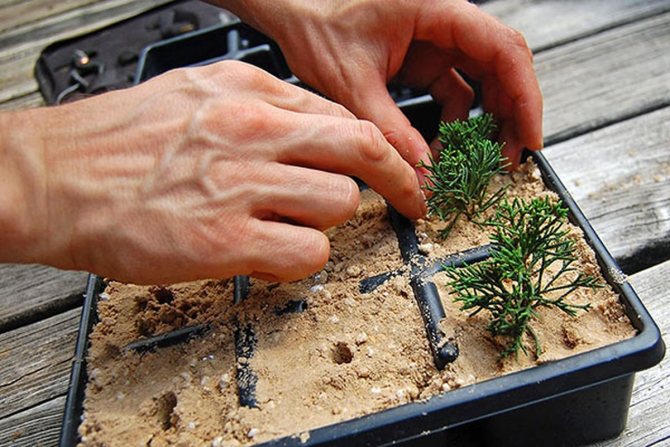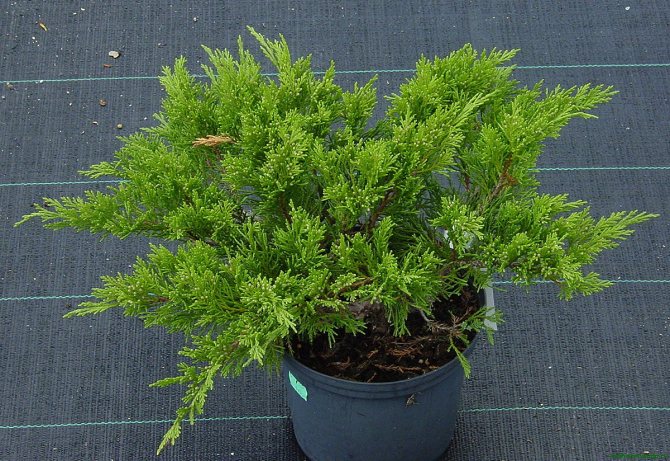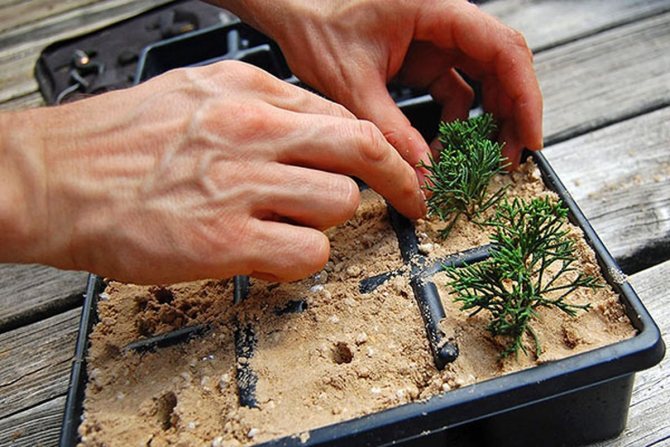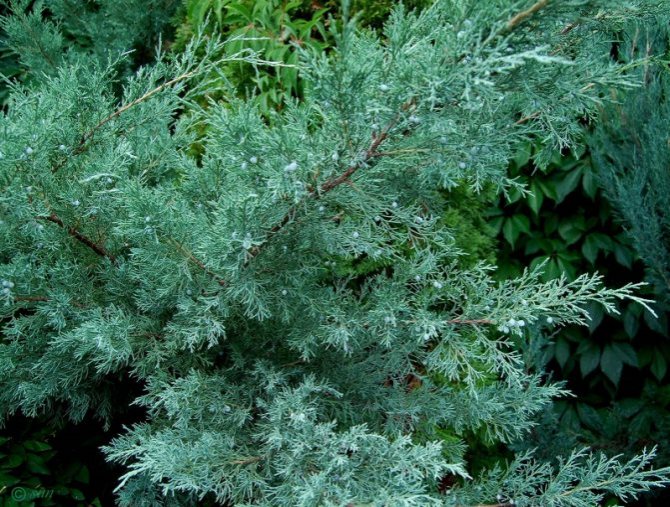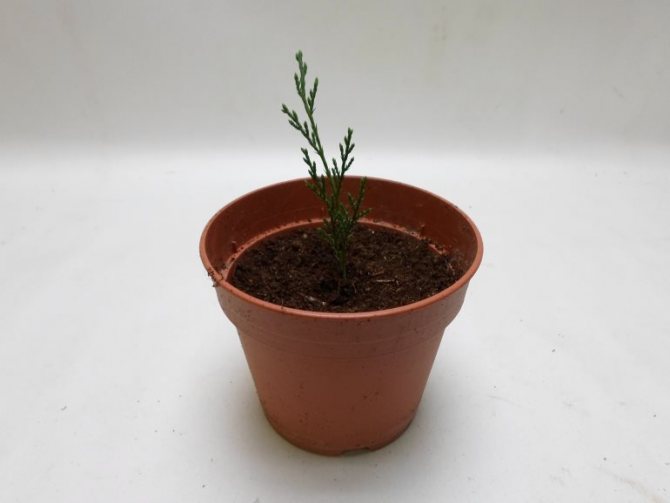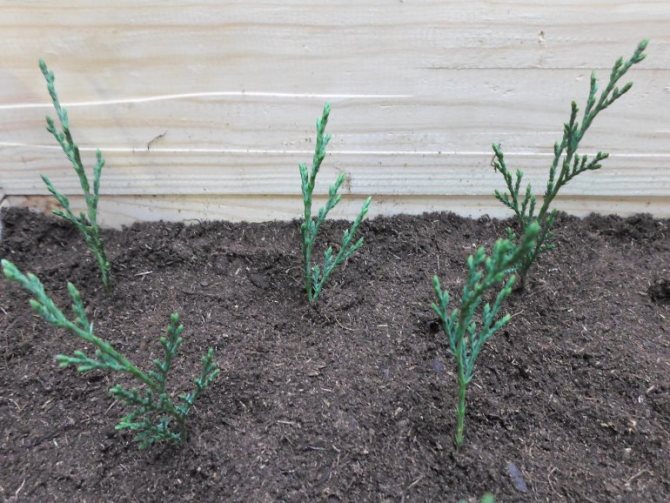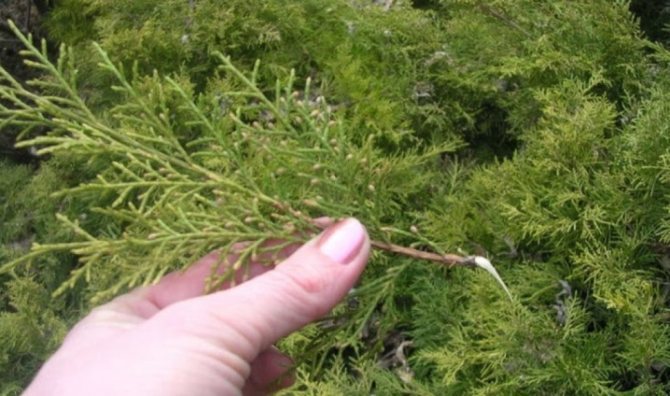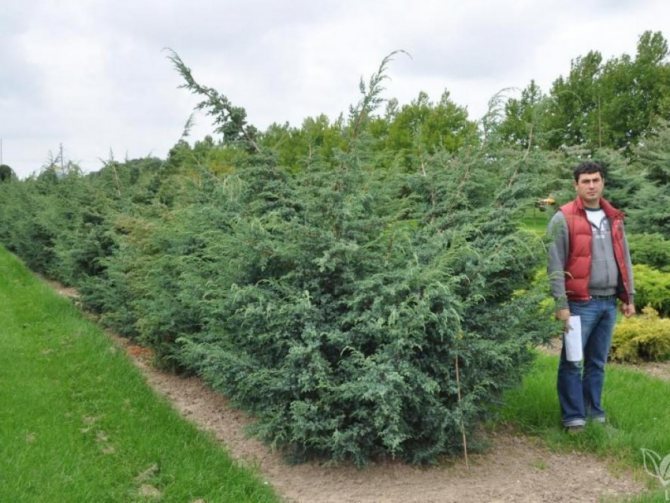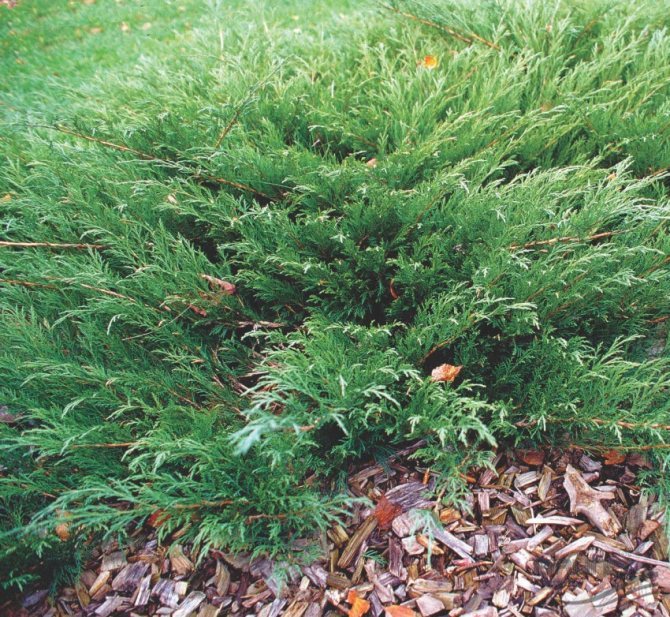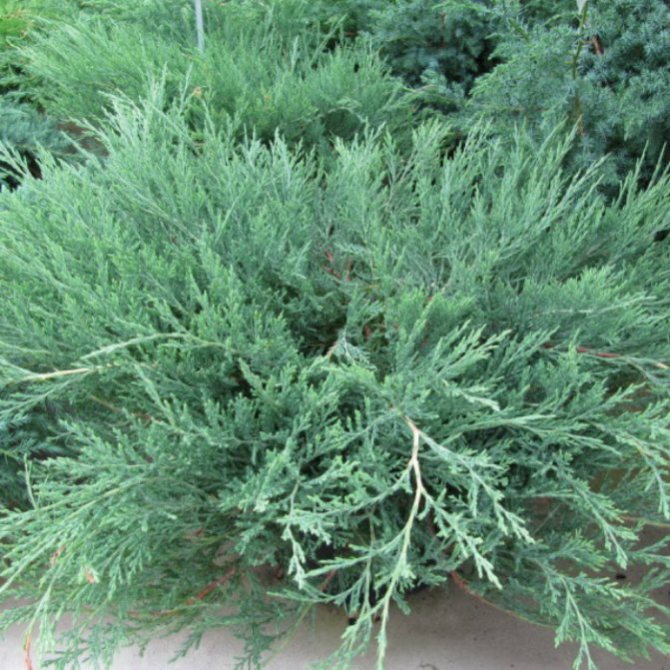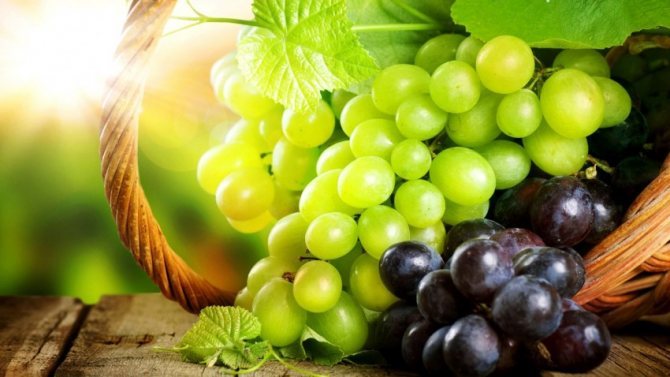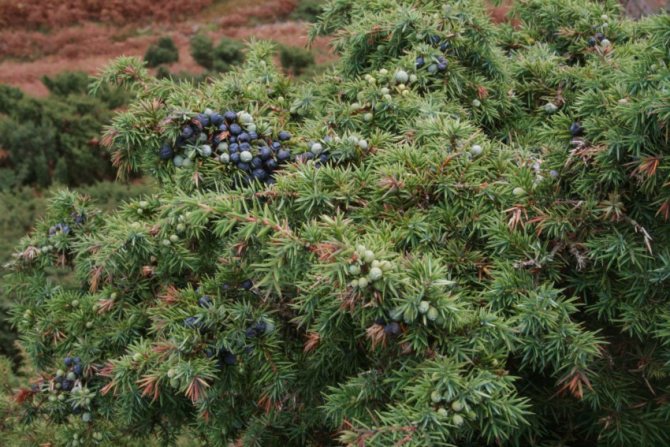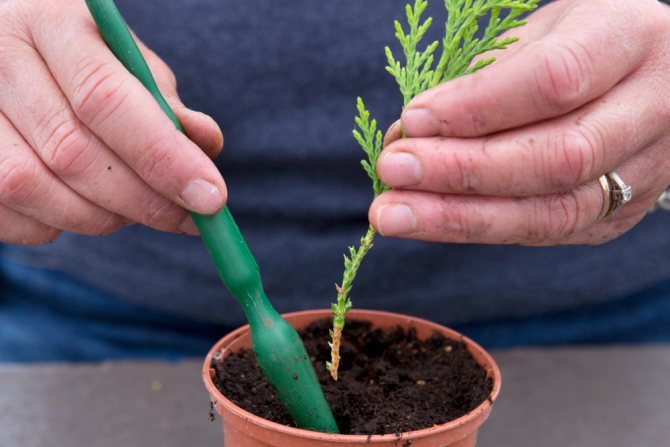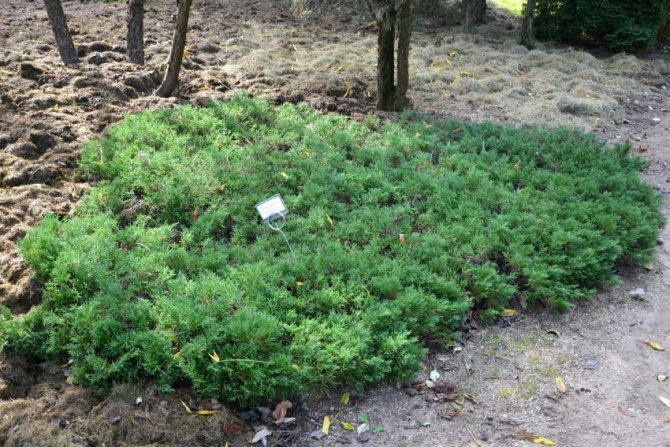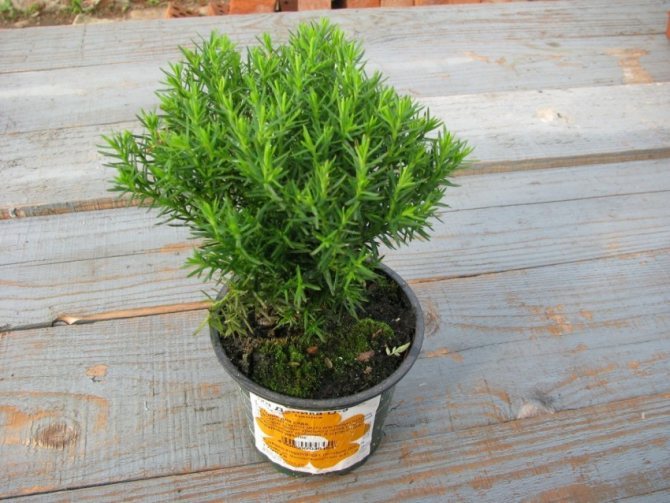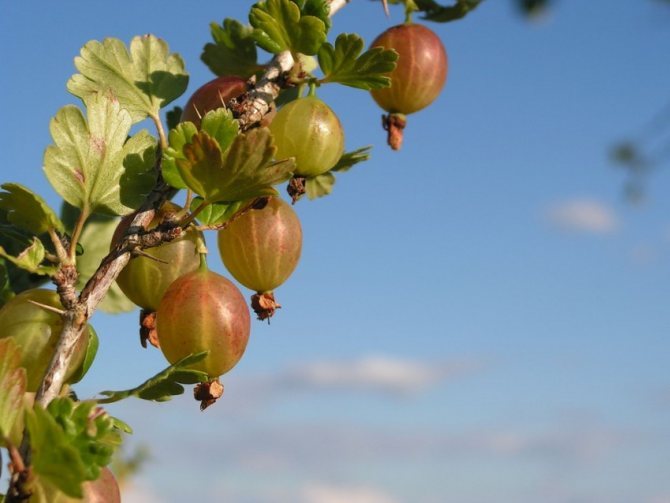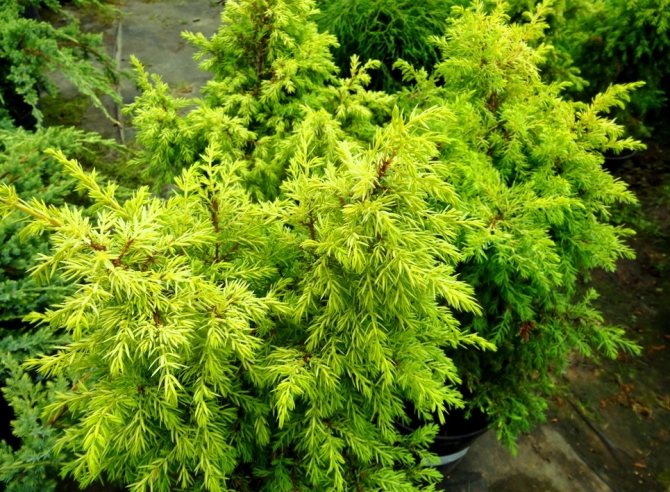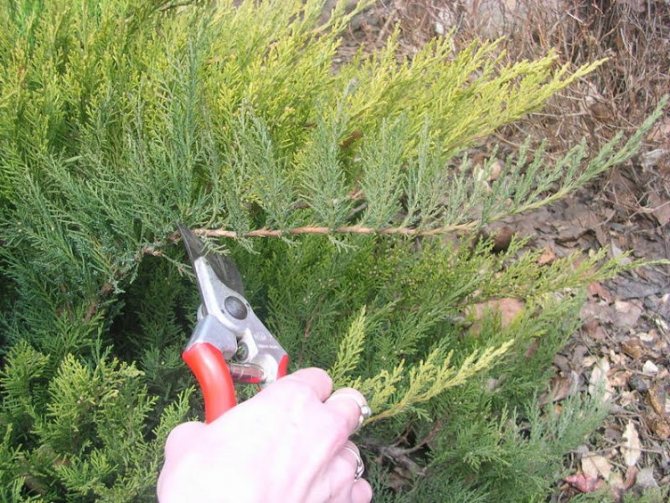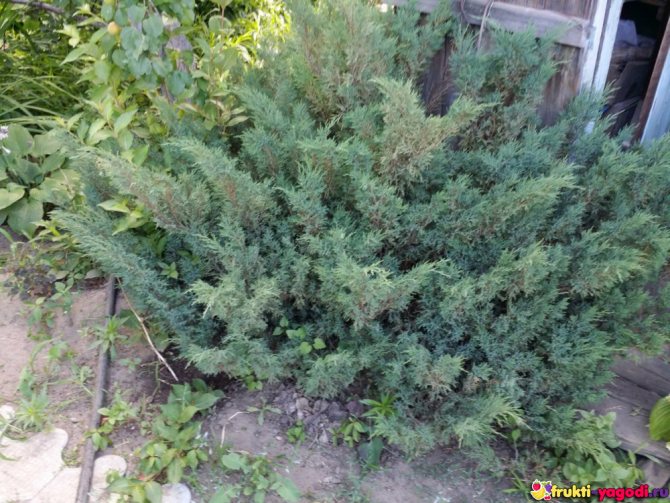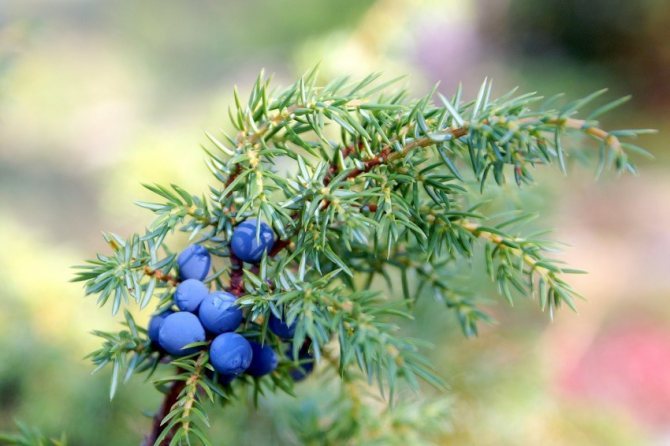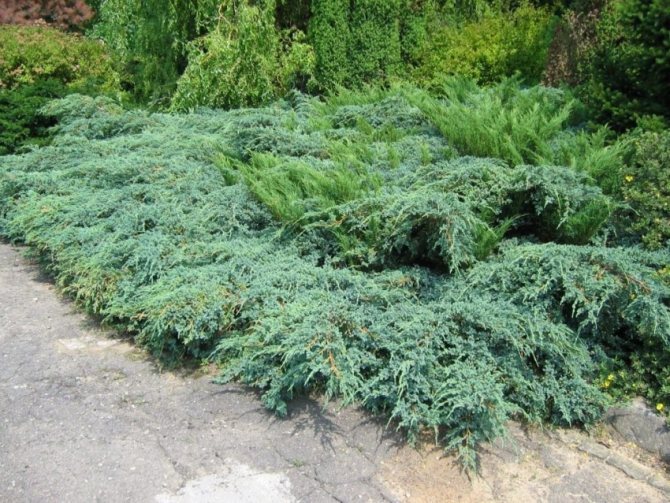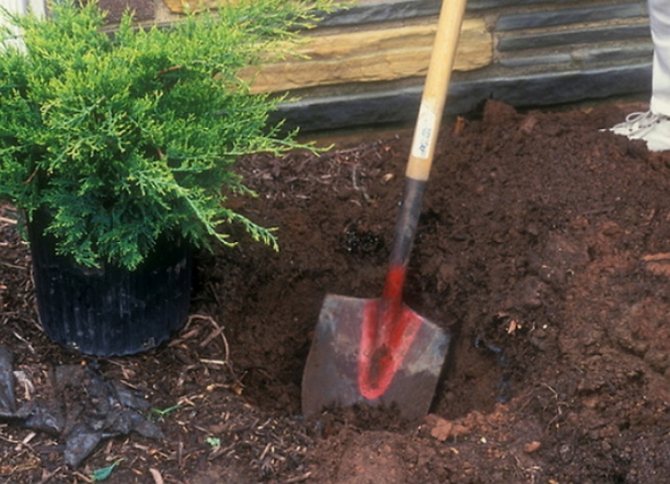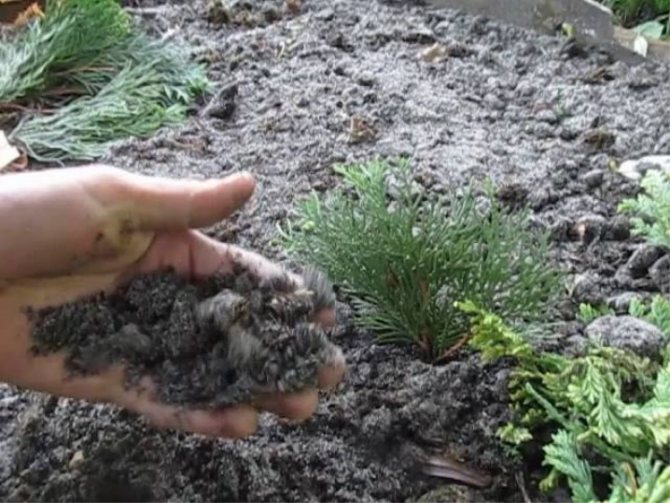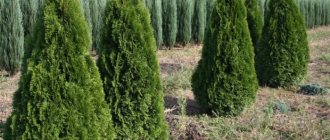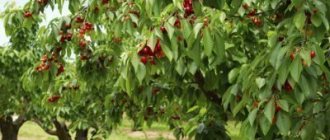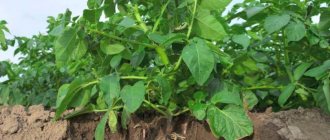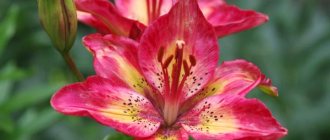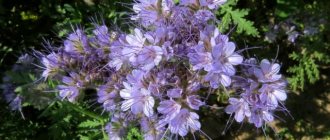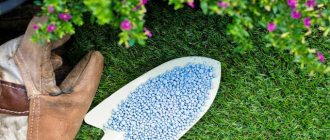Reproduction of juniper cuttings in autumn is permissible. In a way, this period for propagation of a culture gives a better result than the standard period - spring and summer seasons. Often, spring and summer for juniper is too hot and dry, so the survival rate of cuttings becomes worse.
Juniper species for cuttings
Often, after planting one specimen of a coniferous plant, a person wants to get new plants, but without money costs. For such purposes, the preferred option is juniper cuttings. Thus, from one adult plant, you can get such a number of seedlings, which is enough to beautify the entire local area. But, the juniper reproduces not only by cuttings, but also in other ways:
- seed material;
- dividing the bush;
- layering.
Cutting is the simplest method that allows you to get a young plant with all the characteristics of the mother plant. But, not all types and varieties of juniper can be propagated by cuttings; for some, dividing a bush or layering is a more natural option. Cutting is a good option in the case of obtaining new planting material for the following types of coniferous crops:
- Ordinary - the height of a shrub or tree is 5-10 m, the diameter of the trunk is about 20 cm.The crown is dense, bushy, in the case of shrubs - ovoid. The bark is brownish gray. The needles are triangular, pointed, rich green color. The most popular varieties are Green Carlet, Montana and Depressa.
- Verginsky - the crown is ovoid, narrowed, with the growth of the specimen it becomes more fluffy. The bark of the plant is at first greenish, dark, but with age it acquires a brownish-scarlet or dark brown color. Small scaly or needle-shaped needles, painted in a dark emerald color. Popular varieties of the species are Robusta Green, Gray Oul, Glauka.
- Cossack is a creeping shrub. The height of the bush does not exceed 1.5 m. The species grows strongly and rapidly. The needles are painted in a dark turquoise color, they are acicular in young plants and scaly in adult specimens. There are also tree-like versions of the Cossack. Their height reaches 4 m.
- Horizontal - a creeping shrub. The branches are elongated, the shoots are dark turquoise, tetrahedral. The needles are bluish-green. In winter, the needles are often painted brown. Fruits are bluish-black, with a bluish bloom. Popular varieties among gardeners: Andorra Compact, Lime Glow, Prince of Wales, Plumosa.
- Chinese - a tree-like form, the height of the specimen is 8-10 m. The crown is of a pyramidal character, less often - the species is expressed by a spread shrub-like bush. The bark is grayish-scarlet, flaking. The needles are needle-like and scaly. The most popular varieties among plant breeders are Olympia, Gold Coast (green-golden needle-like leaf blades), Yaponika, Strickta.
- Medium is a hybrid of Cossack and Chinese. Bushy form, shoots are curved in an arc. The height of an adult representative is 3-5 m. The most popular varieties are Gold Star and MintJulep.
- Scaly - shrub up to 1.5 m in height.The bark is rich brown, the conifers are tough and sharp. The cones are colored black. The most popular varieties are Blue Star, Rodery, Meyeri.
- Rocky - a bushy or tree-like plant, up to 18 m high. The crown is rounded in shape, actually starts from the base of the trunk. Young shoots reach 1.5 cm in thickness. They are painted in faded green or light turquoise. The leaf plates are needle-like, but more often scaly. Common varieties are Skyrocket, Springbank and Relens.
This is a general list of species that can be successfully grafted.
Juniper care
Place boxes with planted cuttings in a dry warm greenhouse. It must maintain optimal climatic conditions:
- high air humidity,
- diffused light,
- air temperature before bud break - 16-19 С,
- after budding - 23-26оС.
Direct sunlight is destructive for juniper shoots, so if the greenhouse is in the sun all day, it is necessary to shade. Caring for cuttings during their rooting consists in regular watering and spraying. In order to maintain the required humidity in the greenhouse, plants should be sprayed at least 5-6 times a day. The soil should be watered as it dries, but in no case should it be too wet, as the juniper does not like too much water.
The first roots appear on cuttings 50-90 days after planting. Do not rush to transplant seedlings, as the first roots are very thin and can easily be damaged during transplantation. It is advisable to leave the seedlings in the greenhouse for another year, so that the root system grows and gets stronger. If this is not possible, then the seedlings should be transplanted very carefully. Taking them out, they must be together with an earthen lump and with it be moved to the planting pits at a permanent place of growth.
Procurement of planting material
Juniper grown from cuttings can grow both healthy and fluffy, and crooked, weakened. This largely depends on how the planting material was collected. In order for the plant to fully meet all your expectations, you should adhere to the following recommendations.
- As a mother plant, it is best to take a plant at the age of 5-8 years, since at an older age, the ability of conifers to root formation is significantly reduced.
- The parent plant must be healthy, with a dense crown of bright color.
- For creeping varieties, the cut location does not matter. In this case, it is important to choose a well-developed, spreading branch that is exposed to sunlight. This is especially true for bright varieties.
- In cone-shaped, columnar and pyramidal varieties, it is necessary to cut the central shoots of the 1-3 orders of magnitude from above. If you take cuttings from a side branch, you risk getting a juniper actively growing to the sides.
- It is important that the branch intended for grafting has a living apical bud and a full-fledged growth cone, otherwise the seedlings will begin to bush strongly.
- Experienced gardeners recommend using shoots on which slight lignification has already begun, since too young cuttings and too old branches give a low percentage of rooting.
- Procurement of material should be done in cloudy weather or early in the morning. This will significantly reduce the evaporation of moisture from the cut area.
- Do not touch overly thin branches, as they will use up the entire supply of nutrients long before the roots begin to grow. It is best to take one-year cuttings with a length of 20-30 cm.
Read also: Yield of white cabbage from 1 hectare
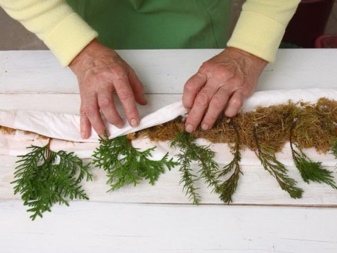
Cuttings obtained from the trunk and large skeletal branches are best taken with a fragment of a tree. This promotes rapid establishment.
It would be more correct not to cut off the branches, but to pluck them with a quick downward movement. If the tongue is too long, then it will have to be trimmed.
If the material is harvested from a large and thick shoot, you will need a garden pruner or a knife with a sharp blade, while the cut must necessarily capture 1.5-2 cm of the lignified fragment.
After the planting material is collected, it is necessary to rid the lower part of the cutting of the needles by 3-4 cm. It is best to do this with your hands, since in this case, when tearing off, wounds are formed, which will contribute to faster root formation.
Immediately before placing in the substrate, the cut sites are sprinkled with "Kornevin", "Heteroauxin" or other stimulants based on succinic acid. But it is not necessary to keep the branches in solutions with an activator - with prolonged exposure to moisture, the bark begins to flake off and the plant rots. For the same reason, it is better to carry out further rooting not in a jar of water, but in a container with a nutritious soil mixture.


What should be the planting material, how to properly plant and grow a plant
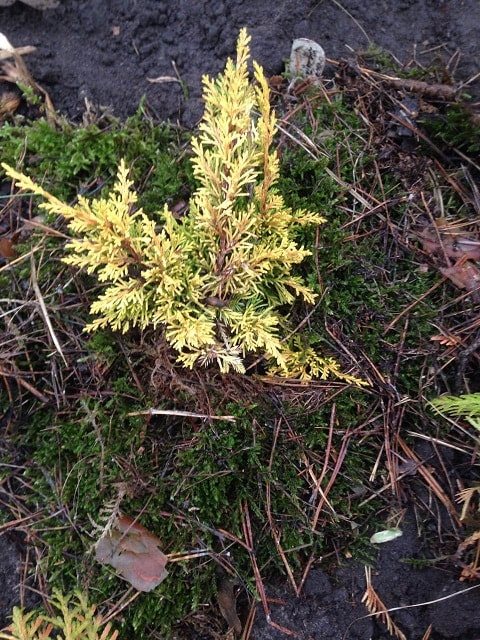

In general, all junipers are unpretentious, frost-hardy and in most cases do not impose special requirements on the soil.
When planting seedlings, it is imperative to do drainage at the bottom of the pit, compact the soil well and do not forget about watering until the plants take root.
All conifers are good for sprinkling during dry periods (for example, as an ornamental spruce).
It is necessary to plant the plant carefully so as not to disturb the root ball. If you have to buy planting material, it is better that it be with a closed root system.
You can transplant at any time. But when purchasing juniper in a container, it is important to pay attention to the root system and the state of the substrate.
If the substrate is loose and the roots do not protrude from the holes of the container, then the plant has been recently transplanted and there is no guarantee that it will take root well.
When wondering where to buy a juniper, you should give preference to specialized stores or garden centers. Read how not to be deceived at the flower fair in our article.
Like all coniferous plants, they need feeding. Unlike deciduous trees, they do not need a lot of fertilizer, because they do not shed their foliage for the winter and it does not take much effort in the spring to build up green mass.
You can feed with special balanced fertilizers for conifersthat are sold in stores. If there is no special fertilizer, you can apply a nitroammophoska. It is better to do this in the spring, before the beginning of the growing season.
Popular varieties for grafting
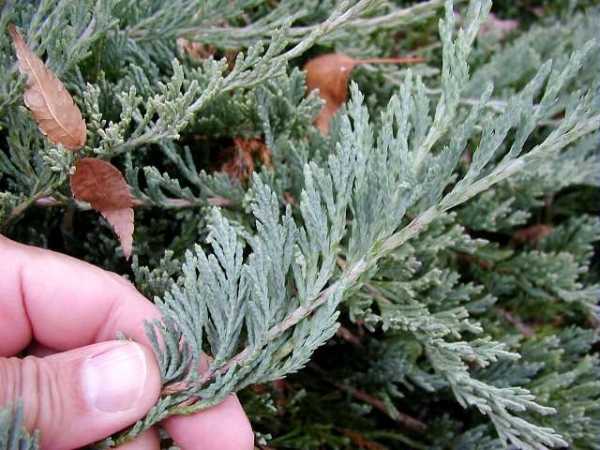

Depending on the particular variety, juniper can propagate easily by cuttings, but some of the common varieties give better results when dividing the bush or in the case of obtaining new specimens by cuttings. Among gardeners, the following varieties are common:
- Mint Julep;
- Meyeri;
- Dream Joy;
- Holger;
- Hit;
- Lime Glow;
- Wiltoni;
- Gold Coast;
- Gold Mordigan;
- Kurivao Gold;
- Golden Star.
Full success in the case of cuttings can be obtained using junipers of the following varieties:
- Meyeri - dense turquoise or dark gray-steel needles. Plant height - from 30 to 100 cm. In addition to cuttings, seed propagation is allowed.
- Holger - height up to 80 cm, needle-shaped leaf plates are painted in bluish-gray color.
- Kurivao Gold is a vigorous variety, it is possible to get it with all the characteristics of the mother plant only by cuttings.
- Schlyager - "growth" up to 25 cm, crown - up to 150 cm in diameter. Reproduction by seeds, layering and cuttings is allowed.
- Mint Julep - mint green color of the crown, you can get new specimens only vegetatively - layering and cuttings.
- Viltoni - bluish-silver crown, when using seeds, the new plant loses the characteristics of the mother juniper.Only vegetative options for obtaining new Wiltoni are suitable.
- Lime Glow is a dwarf, the crown is painted in a bright greenish-yellow color. In the autumn season, the foliage changes its tone to bronze-copper. New specimens are obtained by cuttings.
At the beginning of autumn and the reproduction of juniper almost in winter - at the end of the autumn season, does not differ from this process in the spring and summer.
Breeding by layering
Juniper propagation by layering is a popular vegetative method suitable for creeping varieties. Held from March-April (depending on the climate) to July. Before harvesting the layering, the soil around the plant is loosened, dug up, peat, humus with sand are added and irrigated abundantly.
You can propagate a young shoot growing at or slightly above the ground. The twig is cleaned of needles. Then they cut with a sharp knife at an oblique angle, insert a match, fix it with a hairpin to the soil, cover it with soil. A few months later, when roots sprout from the cut and the juniper grows an aerial part, the branch is cut off and transferred to a permanent place. It is important to transplant a bush with a clod of earth.
Reproduction by layering is similar to cuttings, the difference is that the cuttings are not cut off immediately. However, the traditional method is more popular with gardeners.
Reproduction of juniper in nature
In their natural environment, the reproduction of juniper occurs by seeds. The plant is more often dioecious, which means the presence of male and female trees. But in rare cases it is monoecious and bisexual. Juniper begins to produce seeds from the age of 10-15 years.
Male spikelets are located on last year's branches and consist of scaly stamens with spherical anthers on the underside. Pollen from spikelets pollinates female flowers in the form of greenish buds, where, during germination, a cone berry with dense scales is formed.
The maturation of female cones takes about 1-2 years. In the first year, the fruits are green, only by the second year they acquire the final dark blue color. Each of the scales on female cones has 1-3 wingless seeds. When pollinated, the seed begins its development and becomes fleshy or leathery, which leads to the formation of berries. The number of cones is different and depends on the living conditions. The berries ripen in early autumn.
Further care
You can plant junipers in open ground in the fall or early spring. Planting time depends on the climatic zone. It is important that before the onset of frost, the plant has time to adapt, and in the spring the burning sun does not damage the young needles. It is advisable to plant junipers in acidic, well-drained soils.
When planting a juniper to prevent root injuries, the plant is abundantly moisturized and transferred with a massive earthen clod. The depth of the hole is 2.5 times greater than the coma and on average is 1 m. When planting in groups, the size of the adult plant should be taken into account and the distance between the seedlings should be 2–4 m. The root collar is left 5 cm above the ground. For the prevention of fungal diseases when planting in low areas and places with low light, seedlings are etched with Vitaros or Baktofit.


Juniper is sensitive to moisture stagnation, therefore, a drainage layer of pebbles, expanded clay or crushed bricks 15 cm thick is needed. The substrate for planting is the same as for cuttings. It is advisable to add a universal fertilizer to the soil, for example, nitroammofoski.
After planting, the bush is abundantly irrigated and mulched with sawdust, hay or peat with a layer of 7–10 cm. The soil is periodically loosened, removing weeds. Caring for a juniper in compliance with the basic principles is simple and does not take much time. The plant belongs to long-livers, reaches the age of 300-400 years.
Watering
Juniper is drought tolerant and watering is necessary only in summer 3-5 times per season. One plant will require 20 liters of water.Air humidity is important for the plant and it is useful to spray the crown once a week, which is carried out early in the morning or in the evening after sunset.
Pruning
In spring and autumn, sanitary pruning is carried out, removing damaged and dried shoots. It should be borne in mind that juniper is a slow-growing plant, pruning must be done carefully. The temperature must be at least 4 ° C. Juniper is often used as hedges, the breed is flexible and easy to form. Curly pruning is carried out 1-2 years after planting, when the tree gets stronger. Junipers are popular for making topiary. For complex shapes, frames are used.
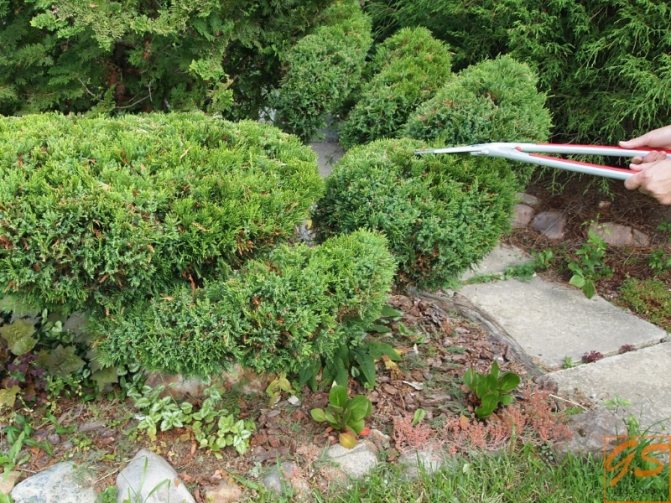

Top dressing
The tree does not feel the need for regular fertilizers; it is enough to add nitroammofosk or Kemira complex fertilizer to the soil in the spring. After feeding, the juniper is watered abundantly.
Shelter for the winter
For the first 2-3 years, the juniper needs shelter for the winter in case of frost and protection from the bright sun in spring. Shelter is not required for mature plants.
Diseases and pests
For juniper, dangerous fungal diseases that cause decay of roots, damage to needles and death of branches. Reproduction of pathogenic microorganisms occurs with stagnant moisture and insufficient lighting. There are frequent cases of rust damage to juniper. With a disease, the needles become covered with brown spots, and the branches dry out. For prevention, a solution of copper sulfate is used, for treatment - fungicides. The preparation is tested on one plant before use. If there are no side effects in a day, and the condition of the juniper has not worsened, then the rest of the plants are also treated.


Among insects, spider mites, aphids, scale insects and moths are threatened. In case of defeat, insecticides are used.
Reproduction of a juniper at home is not difficult if the basic rules are followed. It is easier to use cuttings or layering. In the future, the plant needs minimal maintenance.
Landing time and procurement rules
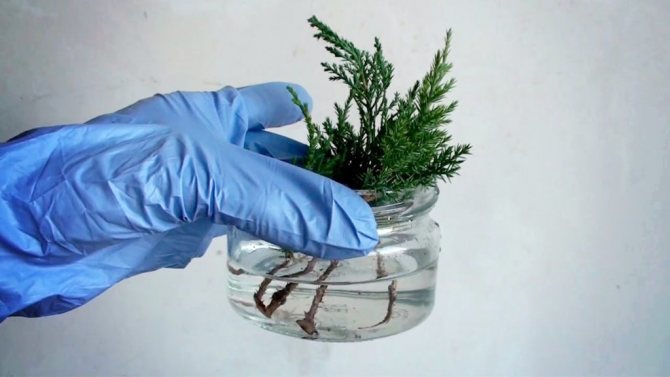

Cutting is a cheap option for getting young conifers. This method has many advantages:
- preservation of varietal characteristics;
- the formation of powerful roots;
- high vitality;
- less susceptibility to pests;
- faster maturation;
- rapid acclimatization and active development;
- the survival rate of cuttings is 2 times higher than that of seedlings.
It is possible to use cuttings to obtain new conifers from spring to the beginning of winter.
For reference!
Some breeders choose the spring-summer season for reproduction, as they consider it more suitable due to the onset of the active growing season for the plant.
Experienced gardeners prefer the autumn period. This is explained by the fact that evaporation of water with the onset of cold weather actually does not occur, which favorably affects the state of the planting material and its development.
Choosing a specific time for planting, you need to focus on climatic conditions. For better rooting of the planting material, it is required that the temperature in the room be at a level of 5 to 25 ̊С. Lower temperature readings or a thermometer mark above the specified limits adversely affect the reproduction process and can lead a new plant to death.
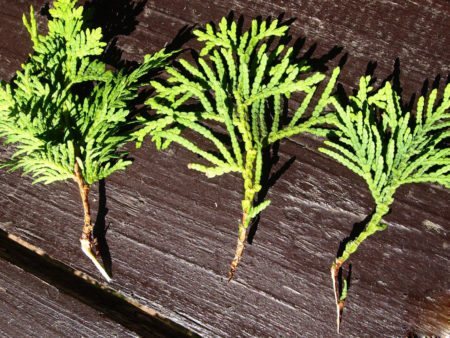

You may be interested in:
How to propagate thuja cuttings in the fall at home At home, thuja propagation by cuttings is best done in the fall. Experienced gardeners recommend this. There is ... Read more ...
To obtain viable and resistant to adverse factors, seedlings are taken exclusively from adult ephedra. Juniper must be at least 8 years old. But, it is undesirable for the ephedra to be more than 10 years old.
Depending on the place from which the cutting was taken, the young ephedra can subsequently develop in different ways.When the apical part of the juniper is cut off, the daughter specimen will tend mainly upward, and in the case of lateral shoots - to the sides. With a vertical crown, branches are also cut vertically into cuttings, and in the case of bushy conifers, lateral shoots are used.
Terms of cuttings
Juniper can be propagated from spring to autumn. However, experienced gardeners note that the procedure carried out at the beginning of the season gives the best results.


Juniper
How to root chrysanthemum from a bouquet at home
The timing of cuttings largely depends on when the cutting is planned to be planted in the ground:
- reproduction of a juniper by cuttings in the summer is carried out if it is planned to plant a plant in the fall. But they are harvested no later than June. Otherwise, they will not have time to take root and will freeze out in winter;
- planting material is prepared in early February for planting in the ground in spring.
In order for the plant to take root in a new place, you need to let it form a root system. This takes about 70 days. Before planting it is not worth it, because the probability of death is high.
Cuttings harvested in late autumn or late winter are moved into the ground in spring. If they were cut in the summer, then it is important to have time to carry out the procedure before the cold snap. With the onset of early frosts, seedlings continue to grow at home until the next season.
On a note! The transplant is carried out immediately after the snow melts. In hot weather, the needles burn out, so there is no need to wait for strong warming.
Instructions for the grower
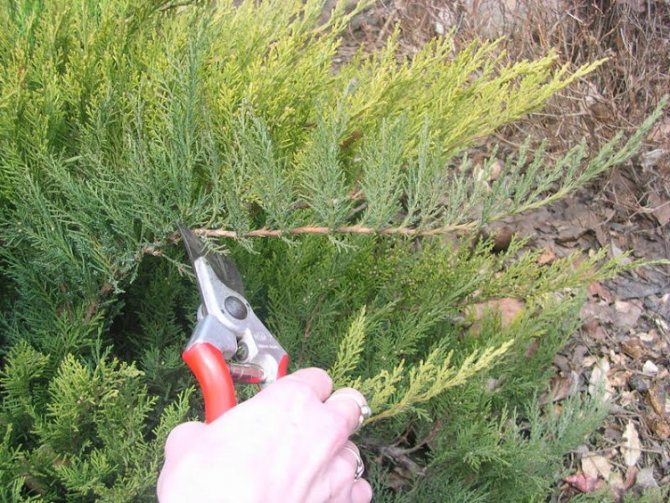

A plant obtained by cuttings and planted in the ground tolerates the acclimatization process more easily and adapts better to unfamiliar conditions. Nevertheless, in order for the plant to receive not only the characteristics of the mother juniper, but also all the bonuses from cuttings, it is required to follow a strictly verified algorithm and strictly follow agricultural techniques.
Material preparation
Before breeding juniper, you need to choose the right material for planting. In this case, powerful and healthy conifers will grow from the cuttings. The main rules for the preparation of planting material are as follows:
- Experienced growers use 8-year-old junipers to preserve all the traits of the cuttings donor.
- The shoot on the cutting is often cut off from the middle part of the mother ephedra in the case of bush forms. In the case of columnar varieties, only the apical shoots are used.
- Not lignified shoots are selected. Semi-lignified branches can be used, but more often young, still green, branches are used as planting material.
- Cut the shoot on a stalk in the early morning hours, when all areas of the juniper are full of moisture.
- In the course of cutting off the shoot, you need to capture a part of the branch on which the cutting previously grew, creating a "heel". This facilitates easier and faster rooting.
- The optimal length of the cut shoot is 12 cm, but longer ones are also allowed - up to 25 cm inclusive.
- All work is performed with sharply sharpened and sterile garden tools.
Attention!
When transportation is necessary, immediately after cutting, the stalk is placed into a moist natural cloth and then into a bag. Storage time - up to 2 days.
Cutting preparation involves 3 stages:
- The needles are cut with a sharp blade - the bark should not be damaged. Only the apical ones are left, which are required for normal air exchange.
- The lower cut is treated with a preparation that stimulates the growth of the root system.
- After 1 day, the cuttings are placed in the prepared substrate.
Juniper is not recommended for rooting in water. In a humid environment, the bark begins to peel off from this ephedra, which adversely affects the viability of the planting material.
Substrate
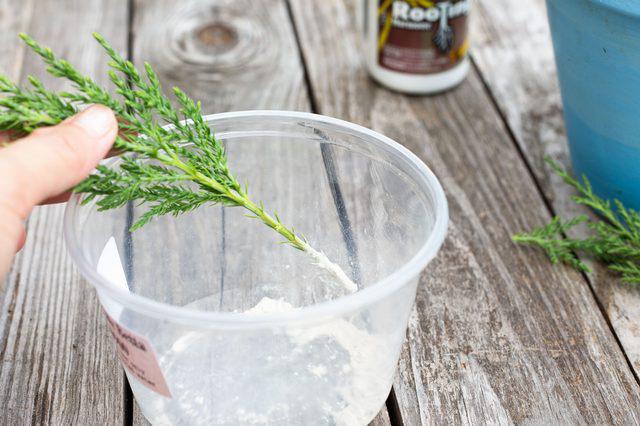

In many respects, the success of rooting depends on the soil mixture in which the juniper planting material is placed. The substrate should have the following characteristics:
- high air permeability;
- high moisture capacity;
- good looseness.
First, a nutritious soil mixture is prepared, consisting of peat and sand, which are taken in equal proportions. To increase the moisture capacity and air permeability of the substrate, a small amount of perlite and charcoal is added.
Stimulation of rooting
Gardeners can use the preparation to root cuttings better and faster. The range of such formulations is significant:
- Kornevin is a drug based on indolylbutyric acid. The solution is made at the rate of 1 g of the product per 1 liter of water.
- Epin - improves immunity and stimulates the formation of the root system. The solution for use is prepared from 0.5 ml of the drug per 1 liter of water.
- Heteroauxin is a phytohormonal drug. The base is β-indoleacetic acid. 1 tablet requires 1 liter of water.
- Zircon is a complex multidisciplinary product. Based on hydroxycinnamic acids. The solution for use is made up of 1 ml of the product and 1 liter of water.
It is prohibited to violate the dosages indicated by the manufacturer, since the opposite process will begin - inhibition of root formation and planting material as a whole.
But, it is possible to use folk remedies:
- weak honey solution;
- composition based on potato tubers;
- willow water;
- yeast-based product.
The cuttings are immersed by a third in a solution of a purchased or folk remedy to speed up the rooting process, and the rest is used to add to the water for watering in the future.
For reference!
The speed of the rooting process is largely dependent on the specific species and variety.
Planting the cuttings in the ground
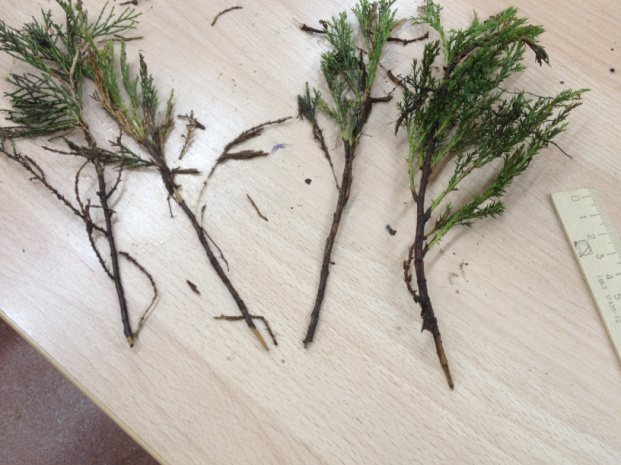

The process of planting a cuttings in a soil mixture is as follows:
- A hole of 3-4 cm is formed, with a circumference of 1 cm. The stalk is placed in the hole, the soil around is slightly tamped and watered. When there are several cuttings in 1 container, then there should be a gap of 6-8 cm.
- The temperature in the room is maintained at the level of 18-23 С. If the mark of the thermometer is lower, the cuttings rot, and at higher temperatures, the soil dries up and the roots die.
- It is required to create the effect of a greenhouse - for this, containers with cuttings are covered with cling film or transparent glass.
Further care involves maintaining normal lighting and periodic watering. The light should be diffused, it is advisable not to allow direct contact with the sun's rays. Regular airing is required so that condensation does not collect under the shelter, otherwise the planting material will die.
For reference!
The plant, before planting in open ground, should be in a pot for up to 2-3 months. Nevertheless, the first roots are formed after 25-30 days.
How can you propagate a juniper bush
Nowadays, several ways are known to grow and propagate plants.
It:
- seeds,
- cuttings,
- layering,
- division of the bush.
Each of the methods has both pros and cons. Let's consider each of the methods below, and describe all the advantages and disadvantages.
- It is worth noting immediately that only creeping juniper varieties reproduce by layering, and only young plants by division. Therefore, these methods cannot be used universally.
- Reproduction of juniper by seeds is the most difficult and time-consuming process. First, the buds take two years to ripen. Secondly, seeds require a long stratification. Thirdly, the seeds do not at all preserve the varietal qualities of the culture. Finally, the seeds have a low germination rate. This method is impractical.
- The most popular propagation method is cuttings: simple and effective. The advantages of this method are: complete transfer of the varietal properties of the plant, a fully formed bush for 2-3 years, good adaptability, and maximum growth rates. Therefore, we will consider this method in more detail.
Interesting fact: if you take the planting material from the very top of the plant, then the young bush will grow elongated upward, and if you take the cutting from the side, then the growth will go in breadth. Juniper has such an unusual feature when propagated by cuttings.
How to propagate a juniper by cuttings
The success of growing by cuttings will directly depend on the strict sequence of all the manipulations. If you dismiss at least one stage, this will negatively affect the further growth and development of the seedling.


- It is necessary to carefully select planting material in order to end up with a healthy and beautiful bush. To do this, you need to follow several rules:
- the minimum age of the plant from which we will extract the material must be at least 8 years;
- you need to try to take a stalk from the middle of the juniper to get wide bushes, or from the top - to get tall plants;
- it is permissible to collect a lot of seedlings from an adult bush, this is enough to ennoble the whole territory;
- you need to choose young, not lignified cuttings, and it is advisable to do this in the morning. At this time, the bush will be maximally saturated with moisture;
- be sure to grab a piece of a branch when pruning, this will contribute to the rapid rooting of the plant;
- the optimal length of the cutting should be about 12 cm. You can also use a larger material, but so that it does not exceed 25 cm.
Be sure to use sharp and sanitized instruments. If the cuttings will be transported, wrap them in a cloth, pre-moistened, and put in a plastic bag. Such storage is possible for two days.
- Preparation of the cutting for the role of a future seedling takes place in several steps, which are also very important to observe:
- it is necessary to remove the needles with a sharp knife, without touching the bark, only the upper ones need to be left;
- it is preferable to treat the lower part of the cutting with a growth stimulant, this will contribute to rapid rooting. To do this, you can place it in a favorable and healthy solution (dilute sugar in warm water 2: 1, or use special powders and pastes).
- After a day, the prepared cutting can be planted in the soil, which you must prepare in advance.
A responsible approach to preparatory procedures guarantees good results. BUT! Junipers cannot be rooted in water. The bark will peel off and this will have a very bad effect on the viability of the cuttings.
- Rooting the cuttings is a very important and basic process that will maximally affect whether the plant takes root or not. It also consists of several stages:
- preparation of a nutritious soil mixture, which should be loose, breathable and moisture-absorbing. It is made from sand and peat 1: 1, and a little wood and perlite are also added. This is necessary to ensure air exchange and moisture capacity;
- we form a depression 3-4 cm, up to 1 cm in diameter, and lower the cutting into it; we crush the ground and water it, but keep in mind that the distance between the seedlings should be at least 6-8 cm;
- for rapid rooting, you need to maintain a temperature of 18-23C (at a higher temperature, the soil will dry out and rot the roots, and at a lower temperature, the cuttings will simply rot);
- remove the pots with cuttings in the greenhouse, if possible, if not, then cover with plastic.
Reproduction by layering
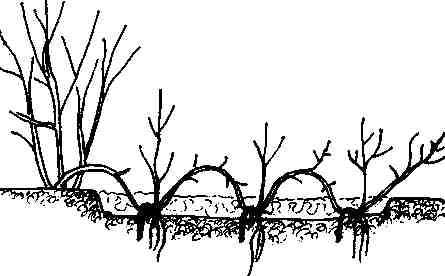

It is quite easy to propagate juniper by layering. This option for obtaining young specimens of ephedra is most often practiced in the case of creeping varieties of culture. Juniper branches are tilted to the ground and gently fix them to it. This is often done using specialized studs or staples.
In the places of fixation of the juniper shoot with the soil, it is required to periodically huddle and moisten the earth. In order for rooting to be successful, exclusively young shoots are used for layering, which have not yet had time to lignify.


You may be interested in:
Reproduction of grapes in summer and autumn in various ways Common methods of propagation of grapes by cuttings and layering allow you to do work at home ... Read more ...
To accelerate the formation of the root system on juniper layering, it is required to prepare the soil in advance. To prepare the soil, the following manipulations are required:
- they dig up the earth;
- the dug-up soil is loosened;
- peat and coarse sand are added to the soil.
The cuttings are rooted for six months or a year. It is permissible to cut off the cuttings from the mother ephedra only after the juniper has developed and is actively growing. The separated cuttings, together with the roots, are transplanted to a separate, prepared for it, place of constant growth.
Reproduction methods
A quick and easy way to propagate a juniper is by cuttings. Other possible methods: seeds, layering, dividing the mother bush, grafting. Reproduction by grafting is rarely used, only for rare and especially valuable varieties. They are grafted to an ordinary juniper, tightly tying the cut shoot to the stock with a polyethylene tape. The method is unpopular due to the poor survival rate of the scion.
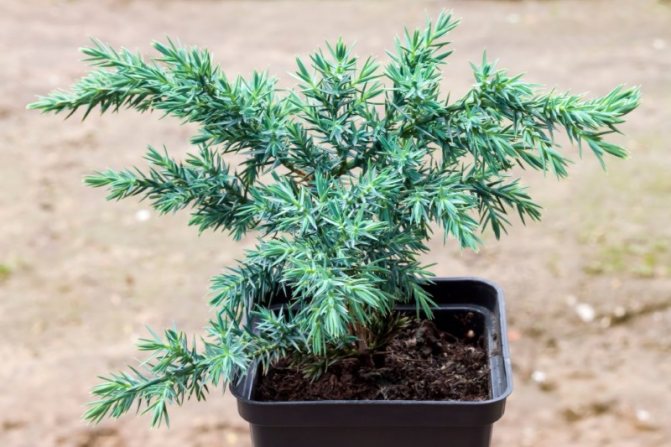

Only young junipers are suitable for dividing the bush. The plant is huddled at the end of spring, watered abundantly during the summer, maintaining the moisture in the soil, but avoiding stagnation of moisture. In August, they dig out, carefully separate the shoots with roots and plant them separately. Each part has its own branches and root system. A young tree needs shelter from the cold.
How to grow from seeds
Growing a juniper from seed at home is not easy. This is due to the fact that the cone ripens for about 2 years. In addition, juniper seeds for successful reproduction and planting ripen only when stratification is fully carried out. And even if all the conditions are met, the seeds have low germination, and the decorative features of the mother tree or shrub are not always passed on to the next generation. When choosing a seed breeding method for juniper, autumn planting is preferable from early autumn to mid-November, or in April after the snow has melted.
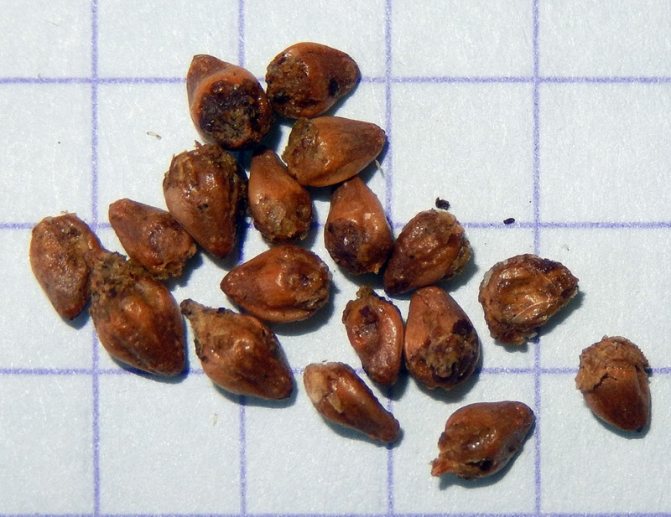

When the buds are ripe, you can move on to collecting them for subsequent planting of seeds. Light purple cones are suitable for breeding, but not overripe. You can collect them by shaking the tree, after laying a newspaper on the ground. It is important to remember that seed germination is low, so planting material is collected with a margin.
To obtain seeds from cones, they should be held in water, rinsed, and then grinded. To accelerate germination, the dense seed coat must be broken. Further processing of seeds is carried out in 3 ways:
- natural stratification - a box with seeds and a moist substrate (soil, peat, sand) is taken outside and left for the whole autumn and winter. With the onset of spring, they are stored in a warm place under a film;
- soaking seeds in an acidic solution with storage for several weeks in ash before planting;
- etching with sandpaper.
The planting site should be warm and lighted, and the soil should be soft and fertile. The seeds are deepened by 2 cm, sprinkled with soil and mulched with peat. For the first 10 days, the sprouts are wrapped, protecting them from the sun. Seed propagation is not suitable for breeding hybrid ornamental species, but it is acceptable for common juniper. Seedlings grow slowly, at the age of 3 years they reach a height of 10–12 cm.
Reproduction methods and features
In the absence of a plant on the site, you can use seed material. But this method is rarely used, since it is complex and takes a lot of time. The first shoots can appear only after a year, so stratification in the garden or at home in the refrigerator is necessary.Variety characteristics are rarely transmitted by this breeding method.
The most valuable varieties of juniper are propagated by grafting. The method is quite complicated and requires certain knowledge and skills. For this reason, in most cases, cuttings are carried out. Evergreen perennial shoots root well, at first they are grown at home or in greenhouses. Creeping forms allow breeding by layering.
Dates of the
Reproduction of juniper can occur all year round, throughout the season, not excluding winter.
- In the summer - with branches and layering. Mostly propagated by creeping, creeping varieties, but this is not the best period for obtaining seedlings from prickly horizontal varieties, harvesting is carried out no later than July, so that the plants have time to take root by winter and not freeze.
- Autumn is suitable for the seed method.
- In winter, it is better to use cuttings, planting planting material in a heated room. It is prepared from the first days of February to be planted next month.
- In the spring, they are rooted with branches or propagated by layering with lateral shoots fixed in the horizontal direction.
Care
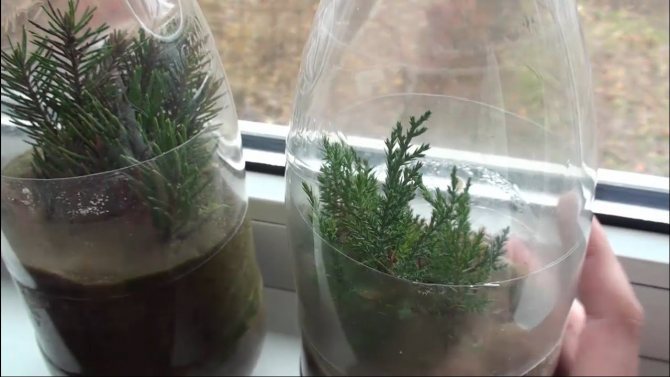

Active rooting of cuttings begins only 2-4 months after planting in the ground. This time frame is rather arbitrary, as it depends on the type of juniper. In this case, it is required to accept that in the summer season the process of formation of the root system can be inhibited until the onset of autumn coolness. The root system for such a period is not able to gain enough strength for an open space, therefore it is recommended to leave the cutting in a greenhouse until the next warming.
In order to prevent stagnation of water near the root system of the juniper, the ephedra needs to be watered with an arrangement, allowing the ground under the plant to dry out. For irrigation, settled water is used, which, according to its own temperature, corresponds to the environment. To prevent fungal-type diseases, when watering, fugnicidal compositions are added several times a year.
Attention!
Due to the duration of keeping seedlings in the greenhouse for at least 1 year, it is required to maintain the transparency of the dome. This is due to the need for bright and diffused lighting, which stimulates the reproduction of the phytohormone responsible for the development and formation of the root system.
When the main part of the root system has already been formed on the cuttings and growths begin to develop, hardening is carried out. For this, the greenhouse must be opened for a short time and fully ventilated. In the winter season, it is recommended to cover young plants with burlap, synthetic covering materials or leaf litter.
In the spring, young junipers need to be transplanted to a permanent place of growth, for which the plants are moved into prepared holes along with an earthen clod, taking into account each of the moments of the process.
Disembarkation to a permanent place
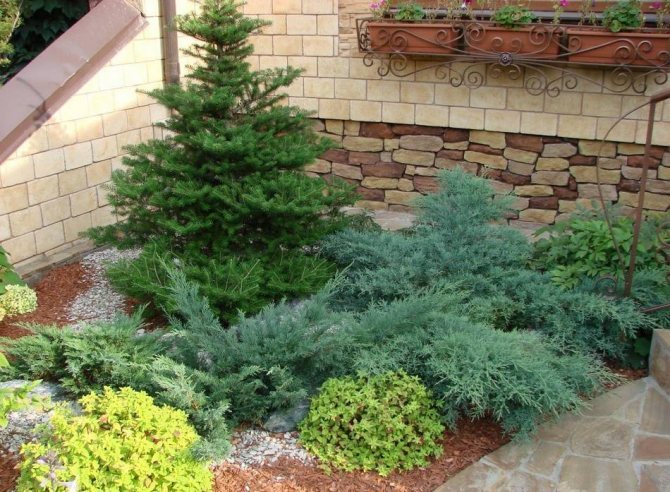

You should not rush to plant young juniper plants. This issue needs to be considered taking into account the full list of factors and rules:
- The planting period of rooted plants is selected taking into account the time for adaptation. If the cuttings were harvested at the end of winter, early spring, then the planting material can be planted immediately - the optimal period is 70 days from being placed in greenhouse conditions. In the case of late harvesting, the juniper hibernates indoors, subject to each of the conventions, until the next spring.
- In the variant of a separate potting rooting of the cuttings, planting in the fall is possible. But, in this case, the plant is moved together with the soil and additional insulation is used. Before full adaptation in the open field, the juniper is highly susceptible to freezing risks, which is highly likely to lead to death.
- Maintaining a coma on the root system plays a major role - the roots of a young plant are easily damaged.The approximate dimensions of the landing hole are 1 m2, they should be 2-3 times large relative to the earthen coma. A drainage layer is placed at the bottom of the pit - this is taken into account in the matter of depth with the condition that the cutting is immersed to the root collar.
- Choosing a place for planting junipers requires bright diffused lighting. The only tolerance is the presence of light shading on one side. According to this characteristic, the exact timing of the procedure is also determined - if the length of the day has already increased, then there are risks of burnout of coniferous landscaping.
- While the plant is still small, the ephedra needs to be protected from direct sunlight and winter frosts. The option of such protection is selected depending on the general conditions - for the winter it is possible to cover the juniper or completely wrap it with insulating materials, and in the summer it is simply to organize temporary shading on excessively sunny days.
Immediately after planting, the juniper needs to be watered - 1 bucket of water is enough without auxiliary impurities. In the future, the ephedra is watered no more than once a month. Fertilizing juniper in the spring requires the use of mineral fertilizers, for example, nitroammophos. With this composition, it is better to limit yourself to 45 g per m2. In the summer season, organic matter is used - compost or rotted manure. Also, fertilizing is applied in the case when the plant develops unnecessarily slowly.
Watering
The duration of rooting of juniper cuttings, subject to the general conditions, is 60-80 days. This period requires constant maintenance of soil moisture. Watering is carried out through agrofibre at least 3-4 times a day.
In fact, the cutting should not dry out. However, rooting of conifers in clean water should not be performed, as this can cause the death of a new plant.
Propagation by cuttings
Juniper cuttings are an effective and easy breeding method available for beginners. The advantages of the method include: fast growth and short adaptation period of seedlings, preservation of decorative properties in daughter generations, resistance to external factors. The method is suitable for all varieties and has a high rooting rate. The varieties that can only be propagated by cuttings include: Meyeri, Mint Julep, Viltoni, Dream Joy, Gol Coast, Lime Glow, Shlyager.
To grow a juniper by cuttings, seedlings are harvested in spring and autumn. The most suitable period for harvesting is March – April. The preferred time of day is morning or cloudy day, when the plant is most saturated with moisture.
Soil preparation
For planting the cuttings, a substrate is made from sod land, humus and peat, taken in equal proportions. You can add sand and crushed charcoal to the mixture. It is advisable to disinfect the substrate by calcining in the oven for 30 minutes at a temperature of 100 ° C.
The place is chosen with moderate illumination and diffused light, partial shade is best. Avoid areas with a high level of groundwater, excessive moisture is detrimental to the root system of the juniper and promotes decay.
Cutting preparation
The tree or bush from which the cutting is cut for propagation must be at least 7–9 years old, this is important for the formation of varietal qualities. Choose a healthy plant with a lush, dense crown. Not lignified, strong and even shoots of the current year are suitable. For growing high varieties, shoots are cut from the upper part, for wide ones - from the middle. The cut is made with a sharp blade or torn off with a quick downward movement, keeping the "heel" - a part of the bark with a layer of wood. The lower part of the shoot is cleaned of needles and lateral shoots, the upper part of the needles is preserved. The length of the cuttings is 15–20 cm. Cut cuttings are wrapped with a damp towel to preserve moisture before planting.
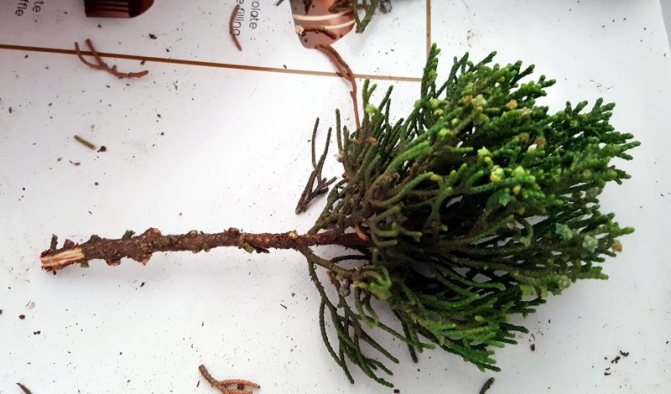

To improve rooting, cuttings are soaked for 10-15 hours in biostimulants, immersed in a third. For example, in Epin, Kornevin or Zircon.In addition to enhancing root formation, the drugs will enhance the immunity of the juniper. When using, the dosage indicated on the package should be observed, if exceeded, the effect will be negative.
How to root
For rooting, juniper cuttings are planted in a pre-prepared mixture. Creeping forms are planted at an angle of 45 degrees, columnar - vertically. The hole for the cutting needs a shallow one, up to 15 cm. After planting, sprinkle with soil, irrigate and cover with a protective film or jar. Suitable temperature for germination is 17–25 ° C. At elevated temperatures, the soil may dry out and dry, at low temperatures, rotting is possible.
The roots appear in about a month, and the final rooting is achieved in 2.5–3 months.
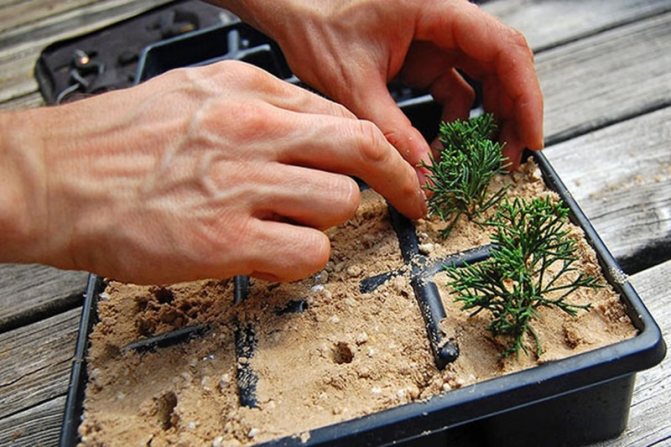

A rooted juniper can be transplanted to a permanent place in 2-3 years with the appearance of new growing shoots. With vegetative propagation by the age of 3 years, the plant reaches an average of 30–40 cm in height.
Rules for planting cuttings in the ground
An illuminated area is allocated for a juniper, partial shade is permissible. The cuttings are moved into the ground along with a lump of earth and try not to damage the still fragile root system.
To plant a juniper, dig a hole, the size of which is 2-3 times the volume of the roots. Drainage must be laid down.
The location of the seedling depends on the variety:
- columnar juniper is placed vertically;
- bushy - with a slight slope.
The plant is buried along the root collar, watered and mulched.
On a note! In the first years of growth, young bushes are covered for the winter and protected from the bright sun. Juniper is drought-resistant, does not tolerate waterlogging of the soil. It is watered about once a month.
At the beginning, it is advisable to fertilize with nitroammophos (50 g per 1 m²). In summer, organic and mineral fertilizers are applied.
To decorate the garden, you should know how the juniper reproduces. It is not a complicated process, but it does require adherence to certain rules. With strict adherence to the instructions, a powerful bush will surely grow from the cuttings, which retains the varietal qualities of the mother plant.
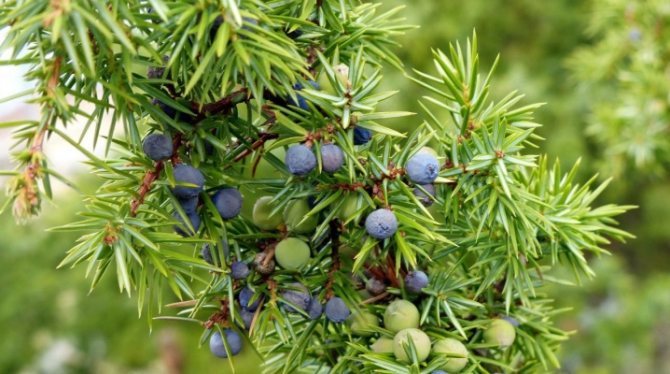

Juniper is one of the most popular crops in landscape gardening. Propagation of this ephedra by cuttings is a relatively simple method that allows you to get many young and strong plants.


What is a juniper?
They are long-lived, so it is very convenient to grow them. The maximum age of the plant reaches about 500 years. People began to use them to decorate various areas: parks, gardens, personal plots, summer cottages, and so on. They are planted in different ways: singly, in groups, in rows, in alleys, on alpine hills, and also as ground cover crops.
This culture is covered with subulate, rigid needle-like needles. In length, it can be from 1 to 2.5 cm. The needles are arranged in several pieces in whorls right along the shoot. The older the plant, the smaller the needles, which become scaly. Juniper cones are very similar to berries due to the fleshy shell that covers them. They usually mature for 2-3 years.
The bushes themselves are different, it all depends on the type of culture: pyramidal, spreading or creeping, and reach a height of one and a half meters. Junipers grow and develop very slowly, except for the fast-growing (for example, Cossack). The culture is widespread in Russia, Europe and Asia. It is in these countries that the most favorable climate for this culture.
It is very important to know that they are very fond of light, and easily tolerate drought, mainly frost-resistant plants, and they absolutely do not care in what soil they grow, even poor soils are suitable. On the contrary, thanks to the strong root system, which loosens the soil, air circulation occurs, thereby making the soil more favorable for other plants.
Preparing the substrate for germinating cuttings
The soil for rooting cuttings must meet the following requirements:
- Be light and loose, without the risk of compaction.
- Be breathable.
- Be moisture absorbing and do not dry out too quickly.
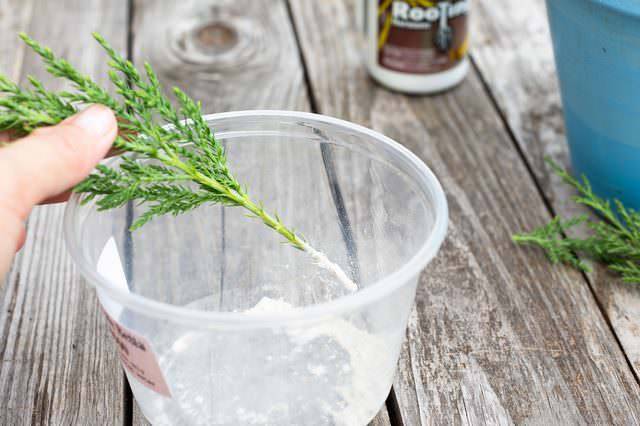

Such characteristics are possessed by a mixture of peat and sand, taken in equal parts without adding lime or ash. Of course, it will dry out quickly enough, therefore, after placing the planting material selected for reproduction and moistening into it, it is recommended to cover the rooting container with a film or transparent polymer cap.
Instructions for growing a juniper from a cuttings
A properly cut stalk must be prepared for planting:
- The lower part is cleaned of lateral shoots and needles, leaving 3-4 cm. If the needles are not removed, it will acidify the soil. The needles should be left on top for aeration.
- The cleaned tip is treated with a growth stimulant such as Kornevin. Warm water with sugar (2: 1 solution) is suitable as a nutrient liquid. Peeling bark can make it difficult to grout, so some gardeners use powdered products or pastes. In some cases, you can limit yourself to moistening the substrate with a stimulating solution.


Work order - You can plant it after a day.
How to root a juniper without the hassle? There are several tricks:
- First, prepare the substrate. The optimal composition for the development of a juniper branch is a mixture of sand and peat in equal proportions. You can add a little crushed charcoal and perlite. But it is worth remembering that junipers do not like high acidity of the soil. If necessary, you can neutralize the increased acidity with lime, lime flour or ash.
- The optimum temperature for germination is from +18 to + 23 ° C. If it is lower, the seedlings will rot. With an increase in the recommended indicators, the discussion process will begin or the soil will dry quickly.
- In the substrate, you need to make a hole 3-4 cm deep and 1 cm wide. The stalk is carefully sent to the prepared hole, the soil is compacted, watered. If a group of cuttings is planted, then a distance of 5-8 cm is observed between them.
- Landings are sent to the greenhouse. A regular pot covered with a bag will do.
Rooting stimulants
The modern market offers gardeners a huge number of drugs to stimulate root formation. Previously, folk remedies were widely used:
- willow water;
- honey;
- potato tubers;
- yeast.
Now there is no need to waste time preparing solutions with your own hands. Purchased drugs are easy to handle and cost-effective.
The most popular are:
- root is a stimulant based on indolylbutyric acid. 1 g of the drug is required for 1 liter of water;
- heteroauxin is a phytohormonal agent. The active ingredient is β-indoleacetic acid. Put 1 tablet on 1 liter of water;
- epin stimulates root formation and improves immunity. Take 0.5 ml for 1 liter of water;
- zircon is a multifunctional complex preparation, a mixture of hydroxycinnamic acids. Add 1 ml per liter of water.
Do not exceed the dosage indicated by the manufacturer, because the opposite effect will occur - inhibition of the planting material.
The cuttings are immersed in the solution for about a third. The remaining liquid is used for irrigation.
Possible problems, tips
It is difficult to breed a juniper on the site, but it is possible, the rooting of cuttings and cuttings does not take much time compared to the life of the tree. On average, long-lived bushes grow for about 300-500 years or more, with which a very small annual growth is associated. During the spring-summer season, it is easy to prepare a large number of cuttings, and even if only 5-10 of them give roots, this is already a very good result.
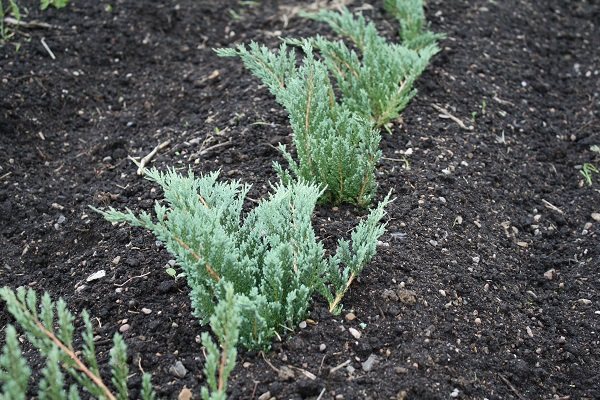

In order for the seedlings to take root well and grow, do not get sick, the following tips and nuances should be taken into account when harvesting, planting material.
- Plucked branches retain the "habits" of the mother plant.Shoots taken from the top will continue to grow straight, while the lateral cuttings will bend, eventually turning into a creeping bush with a spread crown.
- You should cut branches for rooting on a cloudy day or in the evening, when the sun is no longer shining. Shoots should be no more than 20-25 cm long, with needles removed at the bottom.
- When rooting, the shoots should be buried 3-4 cm, watered moderately, since waterlogging of the soil can cause decay. It is better to spray the soil with a spray bottle.
- In spring, it is most convenient to root shoots in a greenhouse, in summer, you can germinate directly on the ridges, covered with a protective film. In autumn and winter, the shoots collected after frost are planted in pots, kept at home under plastic bags cut off with plastic bottles.
- A suitable temperature for growing roots is 23-24 ° C, that is, normal indoor or outdoor in summer.
Reproduction of juniper at home is a lengthy but simple procedure. If desired, any gardener will be able to get as much planting material as is needed for the decoration of a garden, summer cottage, house adjoining plot, practically at no cost.
Evergreen coniferous shrubs are often grown by gardeners to decorate their backyards. Juniper can be propagated in different ways. One of the most popular options is grafting.


How to propagate a juniper: we perform the procedure at home
Selection of cuttings and their preparation
A separate line worth mentioning is the choice of cuttings for propagation, from which it will be possible to grow healthy, completely repeating the characteristics of the mother plants. There are several immutable rules here:
- The material must be cut from the branches in the upper and middle parts of the crown. In this case, the cuttings should not be semi-lignified.
- If you want to grow a sprawling juniper bush, cuttings are taken from the ends of the lateral branches. At the same time, branches taken from the middle of the bush, growing vertically in maximum proximity to the trunk (in columnar varieties and varieties), cuttings will also grow upward and branch little.
- It is necessary to cut the cuttings from the mother plant with a "heel", that is, a small part of the branch on which they grew. This will lead to faster rooting.
- Conifers from harvested cuttings must be removed with a sharp clerical knife without damaging the bark.


To successfully propagate a juniper, cuttings will need treatment with a root stimulant. There are many similar drugs, however, there are secrets here too. So, it is unlikely that it will be possible to root the stalk in a jar with a root-forming solution, since the active exfoliation of the juniper bark occurs in the water, which significantly reduces the productivity of the planting material. The best option is to treat the cut with a powdery root former or paste. Most gardeners even prefer to moisturize the substrate in which the cuttings will be located with root formation stimulants.
Suitable varieties of junipers for propagation by cuttings
Most of the ornamental varieties retain their characteristics only when cuttings. Among the whole variety of juniper, there are several specimens for which seed reproduction is contraindicated.
They reproduce successfully and quickly by cuttings:
- Variety Meyeri (scaly type) - the owner of decorative blue-green needles with an unusual steel shade. This dwarf, growing from 30 cm to 1 m in height, is often used to create bonsai. Annual growth varies between 8-10 cm. It looks attractive due to the dense crown and hanging shoots.
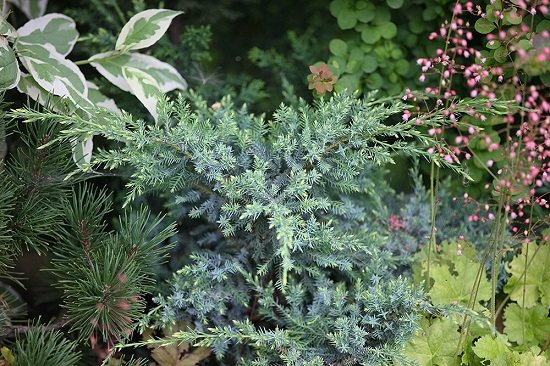

Holger variety - Holger (scaly species) is distinguished by whitish-blue needles and short stature (0.8-1 m). The shoots of the current year acquire a golden color, giving the bush a playfulness. No haircut required, suitable for gardens, roofs and terraces.
- Kuriwao Gold propagates strictly by cuttings. This is a shrub with an asymmetric crown, which grows up to 2 m by 10 years. The branches grow upward, adding 15-20 cm annually. In group plantings, 1.5 m is left between the plants.
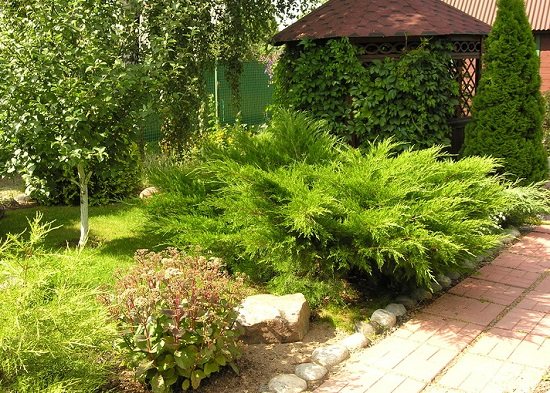

Mint Julep - Mint Julep is the result of crossing the Cossack and many beloved Chinese species. It attracts attention with wide branches covered with mint-colored needles. Feature - in winter, the color of the needles does not fade. By the age of ten it stretches up to 3 m. Resistant to drought, gas pollution, severe frosts.
- Mordigan Gold is a golden-colored variety with pronounced bactericidal properties. The horizontally diverging shoots and the golden shade of the needles give it nobility. Despite its slow growth, it grows up to 2 m in diameter.


Wiltoni and Dream Joy - Wiltoni forms a creeping carpet with silvery needles. It is difficult to imagine that a modest twig acquired in a nursery is capable of expanding on all sides by 3 m or more. In addition to the main lashes, many lateral ones are formed, capable of giving their own roots and shoots. To create a continuous coniferous carpet, you need to plant 1 copy per 2 m2. If you want to acquire a practical lawn in 5 years, you will have to root 2-3 plants per 2 m2.
- Dream Joy is a scaly juniper with long creeping shoots. It grows up to 40 cm, crown diameter 1 m. Annual growth under favorable conditions is 17 cm. Prefers sunny areas, has a negative attitude to compacted soil and excessive moisture.
- Gold Coast is a shrub up to 1 m high with yellow-green soft needles. In the shade, it loses its brightness. It is unpretentious to soil and polluted air.
- Lime Glow is another member of the yellow-crowned family. The shoots, located radiantly, form a small depression in the center. Small needles become bronze by autumn.
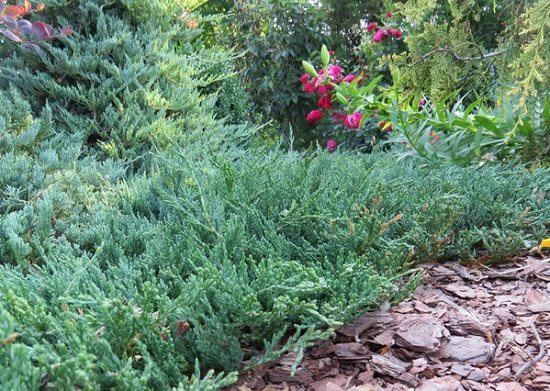

Hit - The Shlyager variety is a dwarf bush up to 25 cm high. It grows unevenly in different directions. The young growth has a pleasant herbaceous color that stands out on the aged needles. Suitable for decorating walking paths, rocky gardens, slopes.
General information
The surface appearance of such conifers is diverse. You can find low and high junipers, as well as ground cover species.
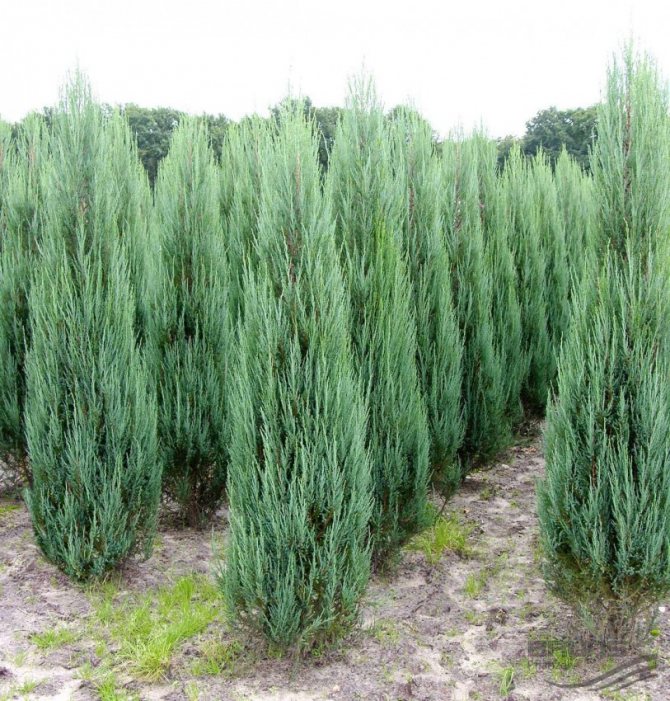

Junipers have low requirements for weather conditions and soil fertility. At the same time, the life span of one shrub exceeds a millennium. Experts note that such a coniferous tree is able to purify oxygen from harmful substances.
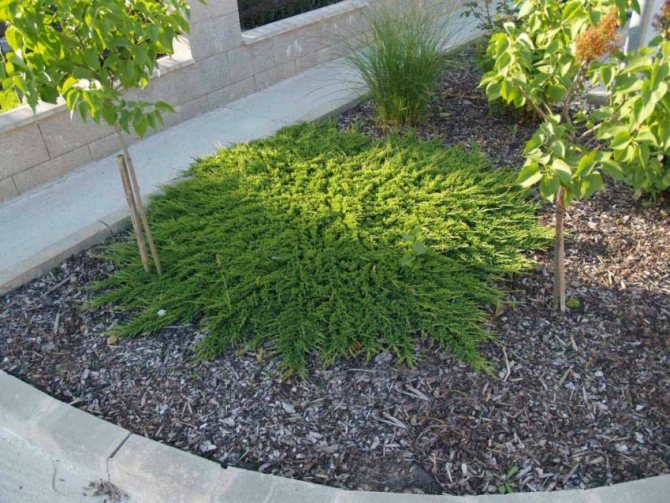

In addition, for a long time, juniper has been used as a traditional medicine, as well as in the food industry.
Layers
This method of breeding coniferous species is suitable for those who already have a plant growing on the site. The method is used only for creeping juniper on the ground, since the branches must touch the surface of the ground, for example, some varieties of the Cossack species. Shrub propagation from a branch is carried out during an active growing season. It takes 6-12 months to root.
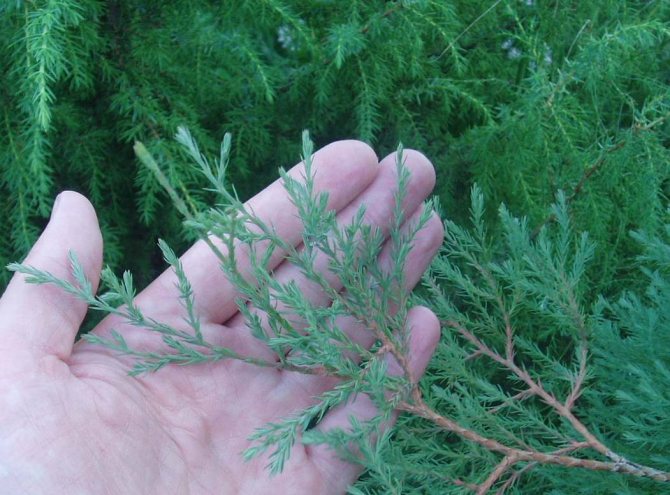

Preliminary preparation consists in abundant watering of the mother plant, loosening and introducing peat, rotted humus and river sand into the soil. Bend the one-year-old shoot to the ground, fix it with hairpins. Periodically loosening around the layering. Spud, water the rooting place. It is allowed to separate the seedling only after it grows the root system, develops the aboveground part.
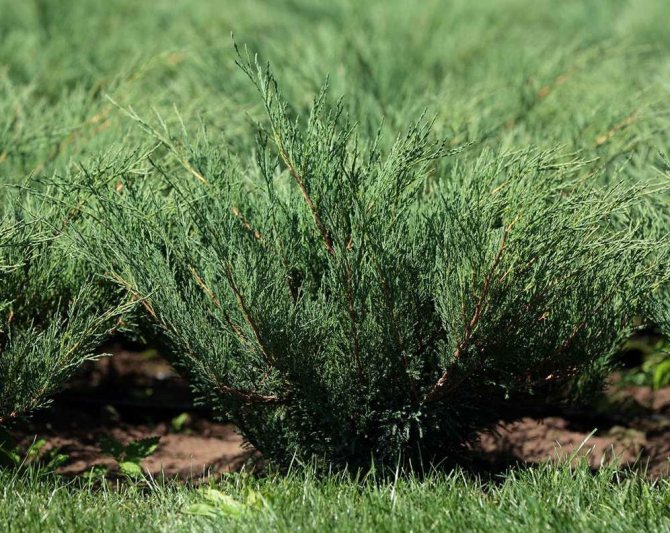

Juniper is most easily propagated by vegetative methods. The choice of method depends on the type of culture. Breeding of creeping forms is carried out by layering, vertical varieties - by cuttings. Rooting is advisable in spring, so that during the active growing season the plant has time to adapt to the new environment.
{SOURCE}
Transplanting a seedling into open ground
The best time to transplant a grown seedling into open ground is spring, from April to May. Seedlings with a closed root system can be planted in autumn, in September-October, but spring planting is still more preferable.
Junipers are demanding on lighting, so the place for planting them should be open and not in the shade of large trees and buildings. Light partial shade or constant illumination by diffused sunlight is allowed. It is desirable that there are no strong winds on the site, especially from the north. The soil is preferable to be loose, well-drained. Common juniper and its Chinese variety do not tolerate dry air, they will grow well if there is a natural body of water nearby.


Different types of juniper prefer different types of soil. For example, Virginia will feel better on slightly acidic clay soils, Cossack prefers lime soil, and Siberian juniper must be planted only in sandy soil. The acidity indicators and the composition of the soil must be checked before planting and, if necessary, brought them to the required ones.
Important! The level of soil fertility has practically no effect on the growth and development of juniper.
Before planting, it is necessary to prepare a sufficient amount of a universal soil substrate with which the planting pit will be filled. To prepare such a mixture, a mixture of soil taken from under an adult juniper or other coniferous plant, coarse river sand and peat is best suited. All components are taken in equal proportions and thoroughly mixed with each other.
It is better to prepare the landing pits in advance so that the soil has time to settle and become saturated with air. Their size must be guaranteed to exceed the volume of the earthen lump on the roots of the seedling. A drainage layer of broken brick, expanded clay or crushed stone is poured onto the bottom of the pit. Then a layer of nutrient soil is poured on top. In this form, the pit is left for several weeks.
Choose a cloudy, cool day for planting. Containers with seedlings are spilled with water in advance so as not to damage the roots when removing. The seedling is placed vertically in a pit on an earthen slide, and then covered with a nutritious substrate. The earth around the trunk is lightly compacted to prevent voids from forming. The root collar of the seedling does not go deep, it should be at the level of the soil. After planting, watering is performed, and then the root zone is mulched with peat, bark or sawdust of coniferous trees.
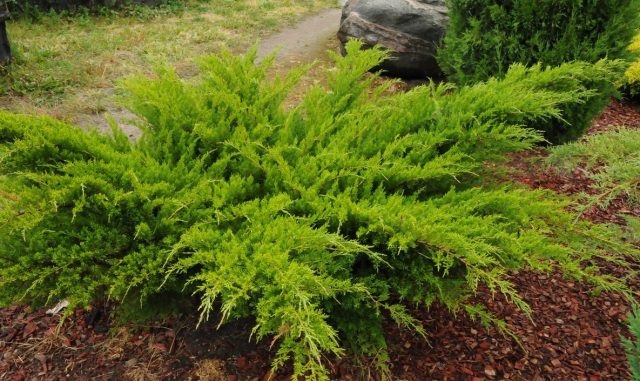

Over time, the juniper grows quite strongly, therefore, when carrying out group plantings, it is necessary to observe certain intervals between neighboring plants. Dwarf species are planted at a distance of 0.8-1 m from each other, when planting larger varieties, it will be advisable to increase this distance to 1.5-2 m. Such a measure will allow plants to avoid competition and develop normally without oppressing each other.
Description of technology


We breed junipers in small pots
There are certain varieties of juniper that are best propagated by cuttings. It:
- Meyeri;
- Holger;
- Kurivao Gold;
- Mint Julep;
- Mordigan Gold;
- Wiltoni;
- Dream Joy;
- Lime Glow;
- Gold Coast;
- Hit.
Substrate preparation
For rooting of blanks, a soil mixture is made from humus and peat taken in equal proportions. It is allowed to add river sand, crushed charcoal and perlite.
Lime, lime flour and ash powder help to neutralize excess acidity.
Preparing cuttings
The harvesting of planting material is carried out throughout the garden season, starting in early spring and pumping in late autumn, but the most suitable time for this is April-May.
When is it better to propagate conifers by cuttings
Cutting of shoots from the mother tree is permissible at any time of the year.The preservation of the genetic material does not depend on the timing of cuttings. Experts are of the opinion that the best time for cuttings is winter. In the first decade, the processes of sap flow are activated in trees.
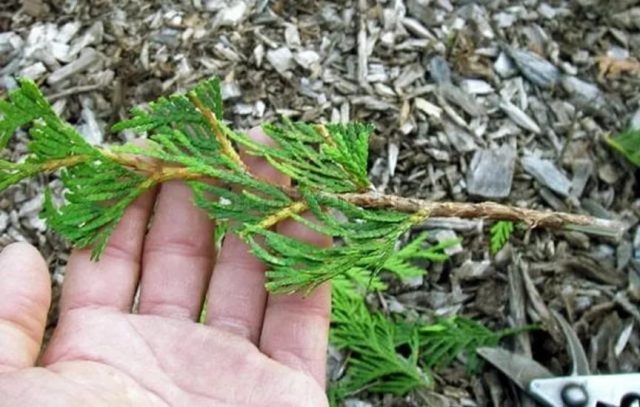

During the period that passes from the moment of harvesting before winter to the beginning of planting, conifers have time to take root well. In summer, strong lignified seedlings are planted on the site.
Reproduction of conifers by cuttings before winter
Harvesting of conifers is carried out before the onset of winter. This increases the plant's chances of a successful spring-summer planting.
To carry out cuttings of conifers before winter, choose the upper shoots or tops. The length should not exceed 20 cm. After cutting, the cuttings are cleaned of needles, leaving only a part of the bark. If in some places the bark is separated, then it is completely removed.
Rooting of conifers by cuttings before winter is possible in several ways or by mixing them:
The easiest and most effective way is considered to be rooting conifers with water. It is not suitable for all types of plants. Shoots of pines, firs, cypress trees take root poorly by water. Thuja and juniper sprout quickly enough.
Reproduction of conifers by cuttings in autumn
It is possible to grow conifers by cuttings in the fall. Autumn cuttings differ little from winter ones. When using the soil, the shoots are left on the terrace or veranda, before the onset of winter they are brought into a warmer room.
Read also How to ripen pineapple at home
Reproduction of conifers by cuttings in summer
For summer grafting of conifers, the method of rooting in boxes is suitable. In summer, shoots need to be watered frequently due to the hot weather. In the fall, they are transferred to the garden bed or taken indoors for the winter to be planted next season.
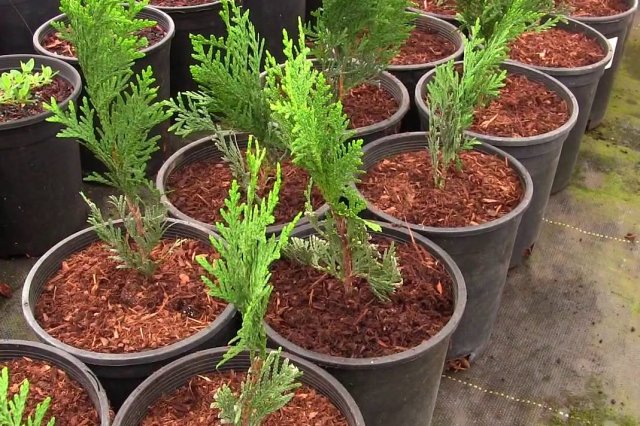

Reproduction of conifers by cuttings in spring
Spring cuttings of conifers are very rare. Experts believe that this period is not suitable for rooting. Shoots spend the summer outdoors, in winter they need room heat.


